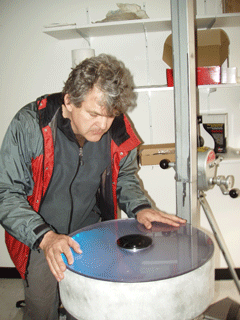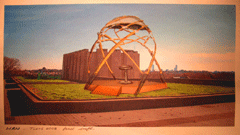Our Sound Environment
Air Date: Week of April 11, 2008

Sound artist Bruce Odland at the "sound dial" for his upcoming installation, "Harmony in the Age of Noise." (Photo: Jackson Braider)
On the campus of Tufts University an anthropologist and a composer have teamed up to create Harmony in the Age of Noise. It’s a new, interactive ,audio-installation designed empower our sense of hearing and train us to see with our ears. Living on Earth host Bruce Gellerman gets an earful from audio-artist Bruce Odland.
Transcript
GELLERMAN: Now, from nature to noise.
[JACKHAMMER, VEHICLE ENGINES]
GELLERMAN: Modern life can get loud.
[JACKHAMMER, ENGINES]
GELLERMAN: We live in a complex sea of sonic information. But what is noise and what is art is in the ear of the listener, according to soundscape composer Bruce Odland.
ODLAND: I like to think that when we screen out all those amazing sounds, we’re doing a huge amount of work. It really costs us a lot of our brainpower to filter out these sounds around us. And it costs us health-wise, and it costs us economically, and it costs us in separation from nature to filter out all those noises, and to take this incredible sense of hearing and instead of using it to find out what’s going on, to use it to pretend nothing’s going on.

Students mapping the sonic details of their environment. (Courtesy of Bruce Odland)
[STUDENTS WORK ON CONSTRUCTING “HARMONY IN THE AGE OF NOISE”]
ODLAND: It makes sense to work with an anthropologist because we’re culturally complicated people and our senses are really part of us, they’re packaged. We ended up with this whole bundle of senses as hunter-gatherers, and we still have them in our ears – we still have hunter-gatherer hearing.
This project is all about capturing and resurrecting that fine, incredible sense of hearing. We just have to use it to decode the noise we make as a culture.
GELLERMAN: So, the idea of Harmony in the Age of Noise is to actually let, let the sounds flow, let ‘em in.
ODLAND: Yeah, the idea is to get a balance between the senses, to not let the visuals override your acoustic awareness – actually get a harmony of your own senses, that they’re balanced, that they’re not insanely visual to the cost of all the other senses. And to pay attention, and to not filter out but to actually actively go out and find out what are the sounds around us and what they mean.

Image from the tuning tube at the "Main Drag" which plays Boston Avenue in the key of "E" in real time over the Internet. (Courtesy of Bruce Odland)
ODLAND: We’re trying to create a perfect sound shape here, so that everything is right with your ears; everything is tuned to the sense of hearing.
[SOUND OF PASSING TRAIN]
GELLERMAN: So, you’re going to construct this – oh boy. Boy, that’s a big sound. What was that?
ODLAND: That’s the fast-moving train headed out from Boston, echoing into this empty loft space that we’re working in, so the loft is the filter for the train.
GELLERMAN: You could use that in the, in your harmony.
ODLAND: Yeah, let’s do that.
[SOUND OF PASSING TRAIN; DOOR SQUEAK; FOOTSTEPS ON STAIRS]
GELLERMAN: Footsteps echo in the stairwell of the vast decrepit building on the Tufts campus.
[FOOTSTEPS WALKING UP STAIRS]
GELLERMAN: Alright, so we just went up a bunch of stairs here, we’re coming – boy, what was this place before?
ODLAND: This was some kind of medical scientific laboratory.

The sound dial. (Courtesy of Bruce Odland)
GELLERMAN: Here where students once huddled over Bunsen burners and test tubes, they’re helping Bruce Odland realize his sonic vision.
ODLAND: And we’ve got sort of like some kind of 1960’s Dr. No set that’s been abandoned by the actors.
[STUDENTS CONSTRUCT “HARMONY IN THE AGE OF NOISE”]
GELLERMAN: It’s an apt description, a case of art imitating a movie. In the 007 film, the diabolical Dr. No uses a gigantic parabolic mirror to focus powerful solar rays. In “Harmony in the Age of Noise,” workers are building a huge parabolic collector to focus sound waves. The collector will be mounted atop a giant gazebo, and the gazebo will be erected outdoors atop the Tufts library.
ODLAND: So when you walk into the gazebo, it’s like being in a four channel set of headphones, but you don’t have to wear anything that separates you from the environment.
GELLERMAN: So, you take the gazebo…and what do you do with it?
ODLAND: Yeah, in the gazebo is going to live this fantastic piece of technology that we’ve come up with for this project called the sound dial. You can think of it as sort of like the steering wheel to a spaceship. When you put your hands on the dial and point it in a certain direction, you start to teleport the sounds from that direction into the four speakers. So, think of it as a psychoacoustic map where, that you’re standing right in the middle of, with a giant compass, and you lay your hands on this compass to activate it, and you point it at something, and it starts to tune into that thing, and brings you sounds and images from that thing that have been collected by 50 or 60 different Tufts students.

Sound artist Bruce Odland at the "sound dial" for his upcoming installation, "Harmony in the Age of Noise." (Jackson Braider)
[CONSTRUCTION SOUNDS FROM LOFT AT TUFTS]
ODLAND: We’ve got the sound dial here. Let me lower it for you here so you can get a good look at it.
[FOOTSTEPS, JOINT CREAKS]
GELLERMAN: I’m not sure, how would I describe this? It looks like one of those, uh, Van de Graaff generators.
ODLAND: It looks like something Tesla might have built, doesn’t it?
ODLAND: When you first walk up to it, it’s going to be basically chanting like a didgeridoo. What that is – is what we call the main drag. We put a tube of 14 feet in length, and a little webcam, and that tube is reporting to the parabolic shape here. And we’re hearing it in real time. And when you walk up to it, the whole world is tuned to the key of E. All the harmonics get regenerated, and it makes a chord – basically Boston Avenue is playing a huge didgeridoo.
[REAL-TIME SOUND FROM 14 FOOT TUBE SUSPENED OVER BOSTON AVENUE AT TUFTS]
ODLAND: I point this dial over at Eaton Hall, for instance, we can start to go into the maps the students have made of Eaton Hall – the computer terminals being clicking and clacking. Or if it point it over towards the gymnasium – this guy thought it was a great idea to go and get the atmosphere of the swim team practicing – what kind of acoustic that is.
[SWIM TEAM PRACTICING IN POOL AT TUFTS]
ODLAND: So this project called ‘Harmony in the Age of Noise” is seeking a balance, seeking a new balance, seeking some harmony, finding elements of beauty in this massive soundscape we made accidentally. Elements of truth in it, elements of reckoning, for instance. And putting it all in one interactive installation where people can come and explore and have their ears opened.
As a matter of fact, your listeners can give us sounds, too, and if they’re out there and recording, and they want to participate, they can. Part of this gazebo is going to have a sort of a bell tower function. So on the hour, every hour, volunteer sounds from the outside world loaded in from the web can be put there, and say – for instance, next Wednesday at 3 am I want my sound to come out, yeah, go to our website and put it up there, and then come on down and listen to your sound.
[SOUND FROM THE TUBE SUSPENDED OVER BOSTON AVE.]
GELLERMAN: Well, Bruce Odland, thank you very much. I really appreciate your time.
ODLAND: You’re very welcome.
GELLERMAN: Composer Bruce Odland and anthropologist David Guss’s installation, “Harmony in the Age of Noise,” launches on April 23rd. For photos and more information check out our website, L-O-E- dot org. Our story was produced by Jackson Braider with help from Margaret Rossano.
[CHANTING SOUNDS FROM THE TUBE SUSPENDED OVER BOSTON AVE.]
Links
Living on Earth wants to hear from you!
Living on Earth
62 Calef Highway, Suite 212
Lee, NH 03861
Telephone: 617-287-4121
E-mail: comments@loe.org
Newsletter [Click here]
Donate to Living on Earth!
Living on Earth is an independent media program and relies entirely on contributions from listeners and institutions supporting public service. Please donate now to preserve an independent environmental voice.
NewsletterLiving on Earth offers a weekly delivery of the show's rundown to your mailbox. Sign up for our newsletter today!
 Sailors For The Sea: Be the change you want to sea.
Sailors For The Sea: Be the change you want to sea.
 The Grantham Foundation for the Protection of the Environment: Committed to protecting and improving the health of the global environment.
The Grantham Foundation for the Protection of the Environment: Committed to protecting and improving the health of the global environment.
 Contribute to Living on Earth and receive, as our gift to you, an archival print of one of Mark Seth Lender's extraordinary wildlife photographs. Follow the link to see Mark's current collection of photographs.
Contribute to Living on Earth and receive, as our gift to you, an archival print of one of Mark Seth Lender's extraordinary wildlife photographs. Follow the link to see Mark's current collection of photographs.
 Buy a signed copy of Mark Seth Lender's book Smeagull the Seagull & support Living on Earth
Buy a signed copy of Mark Seth Lender's book Smeagull the Seagull & support Living on Earth

